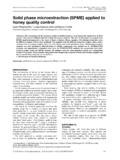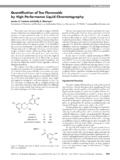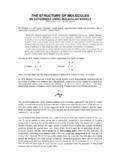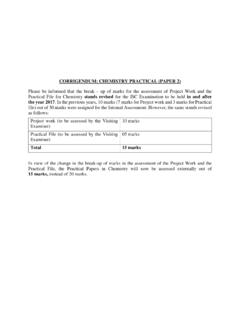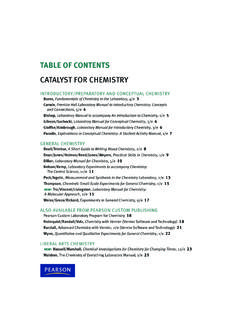Transcription of Hybridization and Molecular Orbital (MO) Theory
1 1 Hybridization and Molecular Orbital (MO)TheoryChapter 10 Historical Models Valence bond Theory (VB) a molecule arises from interaction of complete atoms, bound together through localized overlap of valence shell atomic orbitals which retain their original character. Valence shell electron pair repulsion Theory (VSEPR) predicts Molecular shapes based on valence electrons, lewis dot structures and electron repulsions. Molecular Orbital Theory (MO) a molecule is formed by the overlap of atomic orbitals to form Molecular orbitals , electrons are then distributed into MOs. A molecule is a collection of nuclei with the orbitals delocalized over the entire molecule. and I. Langmuir(~1920) laid out foundations Ionic species were formed by electron transfer Covalent molecules arise from electron sharingTwo Theories of BondingTwo Theories of Bonding VALENCE BOND VALENCE BOND THEORYTHEORY LinusLinusPaulingPauling valence electrons are valence electrons are localized between atoms (or localized between atoms (or are lone pairs).)
2 Are lone pairs). halfhalf filled atomic filled atomic orbitalsorbitalsoverlap to form to form Bond (VB) Theory Covalent bonds are formed by the overlapoverlapof atomic orbitals . Atomic orbitals on the central atom can mix and exchange their character with other atoms in a molecule. Process is called hybridizationhybridization. Hybrid orbitals have the same shapes as predicted by Bond (VB) Theorysp3d2 Octahedral6sp3dTrigonalbipyramidal5sp3 Tetrahedral4sp2 Trigonalplanar3spLinear2 HybridizationElectronic GeometryRegions of High Electron DensityMolecular Shapes and BondingMolecular Shapes and Bonding In the next sections we will use the following terminology:A = central atomB = bonding pairs around central atomU = lone pairs around central atom For example.
3 AB3U designates that there are 3 bonding pairs and 1 lone pair around the central Bond Formation by Sigma Bond Formation by Orbital OverlapOrbital OverlapTwo s Two s orbitalsorbitalsoverlapoverlapSigma Bond FormationSigma Bond FormationSigma Bond FormationTwo s Two s orbitalsorbitalsoverlapoverlapTwo p Two p orbitalsorbitalsoverlapoverlapLinear Electronic Geometry:AB2 Species (No Lone Pairs of Electrons on A) Some examples of molecules with this geometry are: BeCl2, BeBr2, BeI2, HgCl2, CdCl2 All of these examples are linear, nonpolarmolecules. Important exceptions occur when the two substituents are not the same!BeClBr or BeIBr will be linear and polar!4 Linear Electronic Geometry:AB2 Species (No Lone Pairs of Electrons on A)Trigonal Planar Electronic Geometry: AB3 Species (No Lone Pairs of Electrons on A) Some examples of molecules with this geometry are: BF3, BCl3 All of these examples are trigonal planar, nonpolarmolecules.
4 Important exceptions occur when the three substituents are not the same!BF2Cl or BCI2Br will be trigonal planar and polar!Using VB TheoryUsing VB TheoryBonding in BFBonding in BF33planar triangleplanar triangleangle = 120angle = 120ooFFFB oron configuration 2p2s1s B5 Bonding in BF3 Bonding in BFBonding in BF33 How to account for 3 bonds 120 How to account for 3 bonds 120ooapart using a apart using a spherical s Orbital and p spherical s Orbital and p orbitalsorbitalsthat are 90that are 90ooapart?apart? Pauling said to modify VB approach with Pauling said to modify VB approach with Orbital Orbital HYBRIDIZATIONHYBRIDIZATION mix available mix available orbitalsorbitalsto form a new set of to form a new set of orbitalsorbitals HYBRID ORBITALSHYBRID orbitals that will give the that will give the maximum overlap in the correct geometry.
5 Maximum overlap in the correct geometry. Bonding in BFBonding in BF33rearrange electronshydridize porbitalthree sp2hybrid orbitals2p2s The three hybrid The three hybrid orbitalsorbitalsare made are made from 1 s Orbital and 2 p from 1 s Orbital and 2 p orbitalsorbitals 3 sp3 in BF3 Bonding in BFBonding in BF33 Now we have 3, halfNow we have 3, half--filled HYBRID filled HYBRID orbitalsorbitalsthat can be used to form Bthat can be used to form B--F sigma sigma Planar Electronic Geometry: AB3 Species (No Lone Pairs of Electrons on A)BFBF33, Planar , Planar TrigonalTrigonalTetrahedral Electronic Geometry: AB4 Species (No Lone Pairs of Electrons on A) Some examples of molecules with this geometry are: CH4, CF4, CCl4, SiH4, SiF4 All of these examples are tetrahedral, nonpolarmolecules.
6 Important exceptions occur when the four substituents are not the same!CF3Cl or CH2CI2will be tetrahedral and polar!7 Tetrahedral Electronic Geometry: AB4 Species (No Lone Pairs of Electrons on A)Bonding in CHBonding in CH44 How do we account for 4 How do we account for 4 CC H sigma bonds 109H sigma bonds 109ooapart? apart? Need to use 4 atomic Need to use 4 atomic orbitalsorbitals s, s, ppxx, , ppyy, and , and ppzz to to form 4 new hybrid form 4 new hybrid orbitalsorbitalspointing in the correct pointing in the correct C atom orbitalshybridize to form four equivalent sp3hybrid atomic C atom 4 C atom orbitalsorbitalshybridize to form hybridize to form four equivalent spfour equivalent sp33hybrid atomic hybrid atomic in a Tetrahedron Bonding in a Tetrahedron Formation of Hybrid Atomic Formation of Hybrid Atomic OrbitalsOrbitals8 Tetrahedral Electronic Geometry: AB4 Species (No Lone Pairs of Electrons on A)Bonding in CHBonding in CH44 Figure Electronic Geometry: AB4 Species (No Lone Pairs of Electrons on A)9 Tetrahedral Electronic Geometry.
7 AB3U Species (One Lone Pair of Electrons on A) Some examples of molecules with this geometry are: NH3, NF3, PH3, PCl3, AsH3 These molecules are our first examples of central atoms with lone pairs of , the electronic and Molecular geometries are three substituents are the same but molecule is polarpolar. NH3and NF3are trigonal pyramidal, polar in predicting the hybrid orbitals used by an atom in bonding: 1. Draw the Lewis structure 2. Determine the electron pair geometry using the VSEPR model 3. Specify the hybrid orbitals needed to accommodate the electron pairs in the geometric arrangementNH31. Lewis structure2. VSEPR indicates tetrahedral geometrywith one non-bonding pair of electrons (structure itself will be trigonal pyramidal)3.
8 Tetrahedral arrangement indicates four equivalent electron orbitals Tetrahedral Electronic Geometry: AB2U2 Species (Two Lone Pairs of Electrons on A) Some examples of molecules with this geometry are: H2O, OF2, H2S These molecules are our first examples of central atoms with two lone pairs of , the electronic and Molecular geometries are substituents are the same but molecule is polarpolar. Molecules are angular, bent, or V shaped and HybridizationFigure HybridizationOrbital HybridizationFigure REMAINHYBRID REMAIN22linearlinearspsp2 2 pp ss33trigonaltrigonalspsp221 p1 pplanarplanar44tetrahedral sptetrahedral sp33nonenoneCompounds Containing Double BondsValence Bond Theory ( Hybridization )C atom has four electrons from each C atom are in electron in each C atom remains in an unhybridized p orbital2s2pthree sp2 hybrids2pC 11 Compounds Containing Double Bonds The single 2p Orbital is perpendicular to the trigonal planar fourth electron is in the p view of sp2hybrid with p Orbital Containing Double Bonds An sp2hybridized C atom has this there will be one electron in each of the three view of an sp2hybridCompounds Containing Double Bonds The portion of the double bond formed from the head on overlap of the sp2hybrids is designated as a it is not necessary for all the valence electron orbitals to hybridize.
9 For example, ethylene has the following structure:The bonds between C and H are all sigma bonds between sp2 hybridized C atoms and the s- orbitals of Hydrogen. The double bond between the two C atoms consists of a sigma bond (where the electron pair is located between the atoms) and a pi bond (where the electron pair occupies the space above and below the sigma bond. and and Bonding inBonding inCHCH22 OOCompounds Containing Triple Bonds Ethyne or acetylene, C2H2, is the simplest triple bond containing organic compound. Compound must have a triple bond to obey octet rule. 13 Compounds Containing Triple BondsLewis Dot FormulaC CHHCHHC orCHHC VSEPR Theorysuggests regions of high electron density are Containing Triple BondsValence Bond Theory ( Hybridization )Carbon has 4 of the electrons are in sp electrons remain in unhybridized p sp hybrids2pC [He] and and Bonding inBonding inCC22HH22 Figure Containing Triple BondsA bond results from the head on overlap of two sp hybrid Containing Triple Bonds The unhybridized p orbitals form two bonds.)
10 Note that a triple bond consists of one andtwo Bipyramidal Electronic Geometry: AB5, AB4U, AB3U2, and AB2U3 Some examples of molecules with this geometry are: PF5, AsF5, PCl5, etc. These molecules are examples of central atoms with five bonding pairs of electronic and Molecular geometries are the same. Molecules are trigonal bipyramidal and nonpolarwhen all five substituents are the the five substituents are not the same polarpolarmolecules can result, AsF4Cl is an Bipyramidal Electronic Geometry: AB5, AB4U, AB3U2, and AB2U3 Valence Bond Theory ( Hybridization )4s4p4dAs [Ar] 3d10 ___ ___ ___ ___ ___ five sp3d hybrids4d ___ ___ ___ ___ ___Trigonal Bipyramidal Electronic Geometry: AB5, AB4U, AB3U2, and AB2U3 If lone pairs are incorporated into the trigonal bipyramidal structure, there are three possible new shapes.
